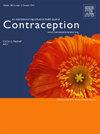Fluidity in contraceptive decision-making throughout pregnancy and the postpartum period among patients at an urban county hospital in Ohio
IF 2.3
2区 医学
Q1 OBSTETRICS & GYNECOLOGY
引用次数: 0
Abstract
Objectives
Contraceptive decision-making is a complex, dynamic process influenced by personal values, experiences, and circumstances. Existing research often captures contraceptive decisions at a single time point, limiting understanding of how preferences evolve over time. This study prospectively examines the fluidity of contraceptive preferences and plans throughout pregnancy and postpartum among patients receiving care at an urban county hospital in Ohio.
Study design
We conducted a prospective, longitudinal study of pregnant patients (N = 123) in 2023 at five time points: three during pregnancy and two postpartum. Participants reported contraceptive method preferences, attitudes, and perceptions at each follow-up survey. We descriptively analyzed changes in planned postpartum contraceptive method and key factors, including contraceptive attributes and perceptions, influencing contraceptive decision-making.
Results
Method effectiveness was the most important contraceptive attribute for included participants at all time points, regardless of contraceptive plan. One-third of participants maintained a consistent contraceptive plan across all five visits. Participants’ contraceptive plans sometimes did not align with their stated method attribute preferences.
Conclusions
Contraceptive decision-making in the perinatal period is a fluid and evolving process. Our findings underscore the need for patient-centered counseling that acknowledges this variability and supports individuals in navigating changing preferences over time.
Implications
Contraceptive plans shift throughout pregnancy and postpartum and may not always align with patients’ stated priorities. Clinicians should provide ongoing, patient-centered counseling that acknowledges the fluidity of contraceptive decision-making and supports individuals in navigating evolving reproductive goals.
俄亥俄州城市县医院患者在整个妊娠期和产后期间避孕决策的流动性。
目的:避孕决策是一个复杂的动态过程,受个人价值观、经验和环境的影响。现有的研究通常在一个时间点捕捉避孕决定,限制了对偏好如何随时间演变的理解。本研究前瞻性地考察了在俄亥俄州城市县医院接受护理的患者在整个怀孕和产后的避孕偏好和计划的流动性。研究设计:我们在2023年对孕妇(N=123)进行了一项前瞻性、纵向研究,分为五个时间点:三个孕期和两个产后。参与者在每次后续调查中报告避孕方法的偏好、态度和看法。我们描述性地分析了计划产后避孕方法的变化,以及影响避孕决策的关键因素,包括避孕属性和观念。结果:无论采用何种避孕方案,方法有效性都是纳入的参与者在所有时间点最重要的避孕属性。三分之一的参与者在所有五次访问中保持一致的避孕计划。参与者的避孕计划有时与他们陈述的方法属性偏好不一致。结论:围产儿的避孕决策是一个不断变化的过程。我们的研究结果强调了以患者为中心的咨询的必要性,这种咨询承认这种可变性,并支持个体随着时间的推移而改变偏好。启示:避孕计划在整个怀孕期间和产后发生变化,可能并不总是与患者声明的优先事项一致。临床医生应该提供持续的、以患者为中心的咨询,承认避孕决策的流动性,并支持个人在不断发展的生殖目标中导航。
本文章由计算机程序翻译,如有差异,请以英文原文为准。
求助全文
约1分钟内获得全文
求助全文
来源期刊

Contraception
医学-妇产科学
CiteScore
4.70
自引率
17.20%
发文量
211
审稿时长
69 days
期刊介绍:
Contraception has an open access mirror journal Contraception: X, sharing the same aims and scope, editorial team, submission system and rigorous peer review.
The journal Contraception wishes to advance reproductive health through the rapid publication of the best and most interesting new scholarship regarding contraception and related fields such as abortion. The journal welcomes manuscripts from investigators working in the laboratory, clinical and social sciences, as well as public health and health professions education.
 求助内容:
求助内容: 应助结果提醒方式:
应助结果提醒方式:


